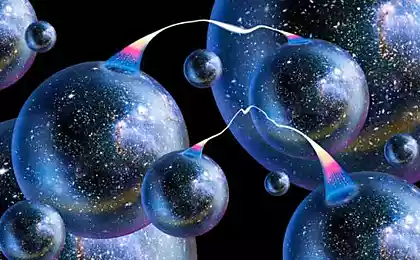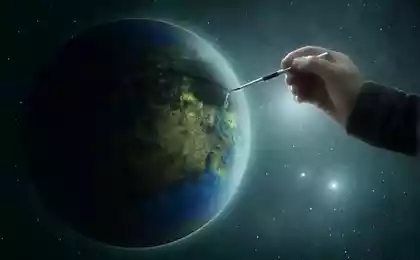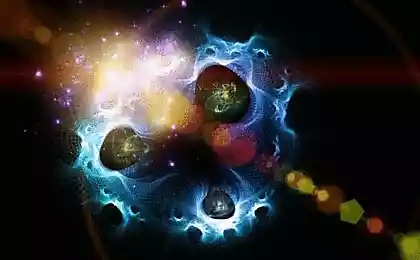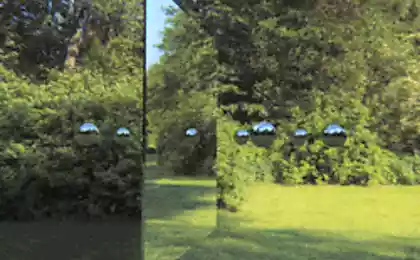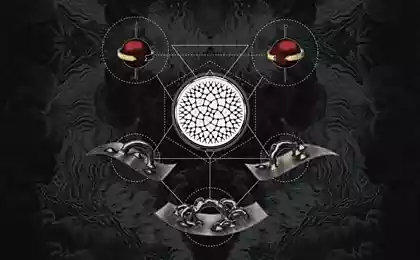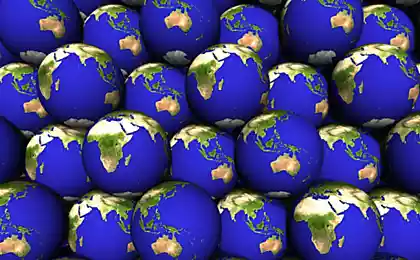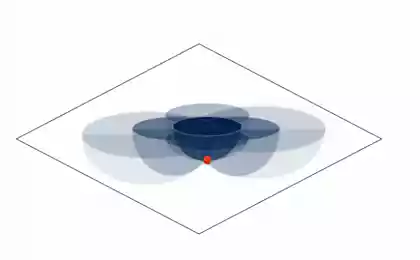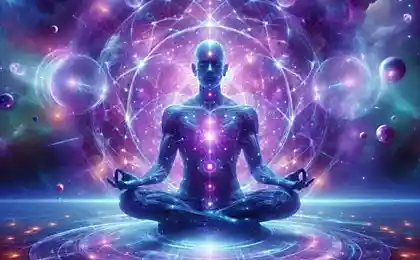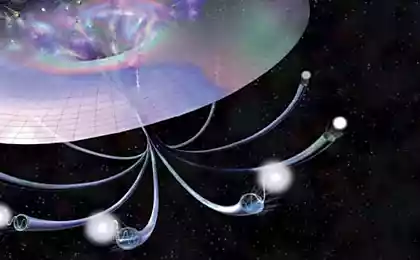740
What the Bible says about quantum cosmology

There is a saying that the history of science is a history of error. New discoveries are always based on previous knowledge. But on the other hand, they very often cross out this previous knowledge. The twentieth century has become an absolute record holder in this regard. It turned out that such a familiar and generally understandable, as it seemed at the end of the nineteenth century, the world around us was in fact not the way we see and feel it.
To begin with, the material world arose from nothing, consists of nothing, and is essentially nothing, since its total energy (and therefore mass) is zero. The building material of this world is emptiness. How well organized and organized this emptiness is!
We, all that surrounds us, all that we can touch and look at, are just the irregularities of emptiness. Moreover, these irregularities – waves, particles, fields – are in all their probable states at the same time (say, the electrons of the atoms of your body are located in their places, as well as in all other points of the Universe, and they will not be anywhere, and all this at the same time, but still most of them, according to the theory of probability, will be “in place”, so you, dear reader, are still quite visible). And this emptiness acquires some certainty (a chair becomes a chair, a table becomes a table, friends become friends, the moon becomes the moon, the universe becomes the universe) only when it interacts with our consciousness. When we observe this table, friends, moon, universe and everything, everything, everything around us, including our own body. This picture of the world was discovered by quantum mechanics, born at the beginning of the last century. And in fact, by the turn of the century of their current juicy colors, quantum chromodynamics and quantum cosmology were added to this picture. And as the founding fathers of quantum mechanics, and later generations of scientists tried to fight with such a paradoxical picture, nothing works. It only gets brighter and clearer. To this day, these, to put it mildly, “strangenesses” of the theory have been definitely confirmed experimentally. In short, it seems that reality is created at the moment of observation, objective reality does not exist!
We all understand and feel physically that we are living in Time and Space. But what is Time and Space? They came with this world and they will disappear with it. It's also the irregularities of emptiness. Most likely, both time and space are some kind of abstraction that arises only in our minds. It is the way we perceive the world. They are relative and depend on the position of the same particular observer. They are ultimately ephemeral. Space-time, according to modern scientific ideas, is not fundamental, it is only a temporary state of vacuum.
This world appeared as a result of the Big Bang. What did it explode? It exploded, as physicists call it, a material point that did not occupy any space, that is, in fact, there was no space. There was nothing in our human imagination. Time and space appeared simultaneously with matter at the Big Bang. But at this point were concentrated infinite (think - infinite!) density and energy. But that's not the point. The point is that if our universe is born from such a point, then it, despite its present, as we think, unimaginably gigantic dimensions, must be approached as a quantum object, as some quark or electron. And this, in turn, means that this world could not appear and manifest as a reality without the presence of an observer. As a well-known scientist, Stanford University professor Andrei Linde noted on this occasion:
Evolution occurs only in relation to the observer. There is no evolution of the whole universe. There is an evolution of the observable part of the universe.
Andrey Linde. A former compatriot, now a professor at Stanford University (USA), one of the authors of the inflationary model of the universe. He has received numerous scientific awards.
This is not the opinion of one of the major scientists. Modern physics, and cosmology in particular, has to put up with such a picture of the world, even if someone does not like this picture very much. Moreover, we can talk here not only about the present, but also about the past: the reality of the past arises only when we are today, according to some signs and artifacts, trying to reconstruct this past. This applies to the reconstruction of the evolution of life on our home planet.
In the beginning, our world had to be unusually orderly. And it's almost incredible. The probability of such a world, which we observe, according to the calculations of the famous mathematician and cosmologist Roger Penrose, is expressed in an inconceivably small number - 1/1010123. This number cannot be written in the decimal system: even if zeros of this number are written on every quark and electron, there is not enough matter in the visible part of our universe to fit this number.
Roger Penrose. The famous English mathematician, physicist, cosmologist. For outstanding services in the development of science, the Queen of Great Britain was awarded the knighthood (this is in addition to numerous scientific awards).
The emergence of life in this world in the form that we know, as well as the emergence of the human mind, events are also almost incredible: their probability is expressed, according to the calculations of the same Roger Penrose, also extremely small number - about 1/101060. The world exists, and we exist in it.
All this can be rationally explained only in two cases: either this world was created by the Supreme Mind, or Nature tends to create an innumerable (perhaps infinite) number of all kinds of universes, one of which quite accidentally turned out to be suitable for the appearance in it of living beings like us.
However, in the latter case, it is still possible to avoid the question: how does nature “know” that it must create an infinite number of worlds (the famous English physicist and cosmologist Stephen Hawking formulates this question as follows: “Why does the universe go to the troubles of existence?”), as well as how and where did information about these worlds and, in particular, about our world arise? Where did the laws of nature come from? And what came first: the laws by which matter exists, or matter itself? Why can the world be described mathematically? Where did mathematics come from, and did it exist before the first creature that could count?
The answers to these questions, most likely, should be found in the same place where the answer to the question of what is information and where it comes from. Our world is informational. Information is at its very core. One of the pillars, one might say, the legend of modern physics, John Archibald Wheeler, was convinced that “everything is information.” Or in his other formulation: “Being is given by a bit” (“It from Bit”).
John Archibald Wheeler (1911 – 2008) He also worked with Niels Bohr and Albert Einstein. One of the “co-authors” of the atomic bomb, the author of the term “black hole”, the scientific director of a whole galaxy of the most authoritative modern theoretical physicists.
Each particle of matter and quantum of energy contains information about the laws and history of our universe. The laws of nature are an integral part of the fundamental information about our world. As noted by cosmologist Alexander Vilenkin, the quantum birth of the universe “is governed by the same fundamental laws that describe the subsequent evolution of the universe.” Therefore, laws must be in place before the universe itself arises. Does this mean that laws are not merely descriptions of reality, but have an independent existence? In the absence of space, time and matter, on what tablets can they be written? Laws are expressed as mathematical equations. If the bearer of mathematics is the mind, does that mean that the mind must precede the universe? "Many Worlds in One: The Search for Other Universes"
Alex Vilenkin, Professor and Director of the Institute of Cosmology at Tufts University (Boston, Massachusetts). His origin you guessed quite correctly - he graduated from Kharkiv University in 1971.
And regardless of the “tablets” on which the information about the fundamental laws is written, it is quite obvious that the Big Bang was not only, or rather not so much a breeder of space, time, matter and energy. First of all, it was the Big Information Bang, when information about our world materialized. More precisely, the part of information that relates to matter itself has materialized. I myself, like many other people, believe that the material is only a small layer of reality. The spiritual world is incomparably vaster and richer, and its laws are no less regulated than what we call the laws of nature. The only problem is that we know much less about spiritual laws.
Astounding as it may be, today’s scientific understanding of the universe is closer than ever to the Christian. If any of the wisest men of science at the very beginning of the twentieth century were able to predict the real scientific discoveries of the next century concerning the structure of our world, and the ideological conclusions that can be drawn from these discoveries, his colleagues would at best declare such a person to be a conductor of especially sophisticated "Popular propaganda."
So what are these intersections? Let’s try to briefly list them.
1. The world has a beginning, it is created from nothing.
“I beseech you, my child, to look at heaven and earth, and when you see all that is in them, know that God created all things out of nothing, and that so the human race also happened,” the mother says to her son, urging him to bravely accept death from the persecutors of the Jews in one of the books of the Old Testament (2Mak 7:28).
2. Time also has a beginning, and has arisen with the material world.
“By faith we know that the ages are made by the word of God, so that out of the invisible came the visible,” writes Paul (Hebrews 11:3). In more modern terms, ages, time, were created by the word of God, and at the same time, together with time, the visible, that is, the material world, arose from the invisible (spiritual).
In many Orthodox prayers, you will find such an appeal to God: “Light to the giver and the Creator for ages, O Lord...” Christians turn to God as the Creator of light and time. It has a time and an end with this world.
And the angel whom I saw standing on the sea and on the earth lifted up his hand to heaven and swore to him that liveth for ever and ever, who made the heavens and all that is on it, the earth, and all that is on it, and the sea and all that is in it, that there shall be no more time. (Rev. 10:5,6). Eternity, from the Christian point of view, is not infinite time, but the absence of time.
Time is an attribute of the material world. God is timeless, He is eternal. With the end of the material world comes the "Kingdom of Heaven", man also passes into eternity, and time ends. Therefore, this world is called in Christian texts “temporary peace”. The scientific community as a whole is forced to agree that our world is doomed, sooner or later it will cease to exist. The space-time of our world, in our view of it, will also disappear.
“For a thousand years are before your eyes as yesterday, when it passed away,” says Moses in the Psalms (Psalm 89:5). For God, a millennium, whether past or future, is equivalent to a day already past. God, as we said, is timeless.
... “The Lord is one day as a thousand years, and a thousand years as one day.” – Peter 2:8
4. In the beginning was the Word.
In the beginning God created the heavens and the earth. This is the first line of the Old Testament book of Genesis.
“In the beginning was the Word, and the Word was with God, and the Word was God. It was in the beginning with God. All things began to be through Him, and without Him nothing began to be that began to be.” These are the first lines of the Gospel of John. God the Father created the world through His Word, which was also God. It's God the Son. The divine principle of Christ. Another name of Christ is God the Word. What is the word in the human sense? This is a formulated (formulated, formalized, as you like) thought. In modern language, this is information.
A little above we noted that the Big Bang was, could not be, not so much an event that gave rise to matter, space and time. First of all, it was a big information explosion. Information about this world, about its laws, was originally laid in this world. There is no other way to explain the laws of nature. It is impossible to explain the orderliness of this world, its progressive development, from the point of view of modern evolutionists. At the time of the Big Bang, information about our world materialized. And in this thought, as in all previous ones, the priority belongs to religious knowledge: in the beginning was the Word.
5. Universes without an observer have no physical meaning.
Modern physics cannot describe the birth of our universe, nor its evolution, without using the concept of an observer. According to quantum mechanics, without interaction with the observer, the world cannot emerge from superposition – all its probable states in which it must simultaneously coexist. The theory of relativity requires the position of the observer, with respect to whom we can speak of time and space. There is no absolute time and space. Without determining the location of the observer in space-time, we cannot determine either.
Christianity says that God created this world for man, “the spectator of this world.” “And God said, Let us make man in our image and in our likeness, and let them have dominion over the fish of the sea, and over the birds of the air, and over the beasts, and over all the earth, and over all the filth that creep on the earth” (Genesis 1:26). Without man, according to Christianity, this world is meaningless.
Moreover, there is a clear indication in the Bible that our world is based on the laws of quantum mechanics, which I hope to explain separately.
6. The anthropic cosmological principle (the statement that this world has exactly those physical parameters that seem to be specially created so that a person could exist in this world) in this context loses the aura of a certain scientific “curiosity” and becomes quite natural, and not just in a strong, but in its most rigid formulation. Information about life in general and about the appearance of man must have been, could not have been, laid in the Big Bang.
7. The probabilistic, quantum-mechanical structure of our world allows us to explain how it can combine the free action of God and the free will of man. I hope we can talk about this in detail later.
8. According to Christian beliefs, we live in a cursed world. The curse of this world is entropy (this is the very thing because of which everything in the material world wears out, ages and sooner or later collapses, and we die because of it). And most likely, it is entropy that sets the direction of time. The law of non-decreasing entropy, i.e. the constant growth of chaos, condemns our world to destruction. But the same law says that somewhere out there, at the very beginning of the universe, the world was wonderfully ordered, its entropy was zero or close to zero.
The Bible says the same thing. “And God saw all that he had made, and behold, it was very good” (Genesis 1:31). The original world was perfect. There was no place for death or entropy. But after the fall of Adam and Eve, God curses the material world, saying to Adam, “Cursed is the earth for you, you will eat of it with sorrow... until you return to the land from which you were taken, for you are dust and you will return to dust.” (Gen. 3:17-19). And since then, according to the Apostle Paul, "all creation together groans and suffers to this day" in the hope that together with man "will be liberated from slavery to corruption into the freedom of glory of the children of God [i.e., redeemed, saved, liberated from corruption people - D.O.]." (Romans 8:21-22). In other words, man, having passed his way, must return to his original, "non-sinful" state, and with it the whole world will be liberated from corruption and death.
9. Living nature differs from inanimate nature in that life itself contains the possibility and necessity of self-organization and creativity. It is the same in its concise form, says the Bible.
If you read the first chapter of Genesis carefully, you will notice that God creates inanimate nature with His Word. But all living things (with the exception of man, whose creation is fundamentally different from everything else) entrust the creation of earth and water. And God said, Let the earth grow green, grass that sows seed, and a fruitful tree. And it was. And the earth produced greenery, grass, and wood (Genesis 1:11-12). And God said, Let the waters of reptiles produce a living soul, and let the birds fly over the earth. And God created the great fishes, and every soul of the animal reptiles which the waters produced. (Gen. 1: 20-21). And God said, Let the earth produce a living soul... beasts and filth and beasts of the earth. (Genesis 1:24). In other words, God endows the earth and water with creative potential, as if inviting matter to co-creation, what is now commonly called “self-organization.”
10. Life is a mechanism for resisting entropy. But the living cannot overcome death, which occurs regardless of the individual ability of organisms to fight it. Death, like entropy (God’s curse of the earth), according to the Bible, entered the world at the moment of the fall of man (According to the Apostle Paul, “by man sin entered the world, and by sin death...” (Romans 5:12)).
The mechanisms of "natural" death in different groups of living beings are sometimes very different. In many of them (including a person whose most cells are capable of dividing 52 times, and that is the end of it, although most often, as we well know, they die well before their limit, estimated at about 120 years), body death is genetic. There are many potentially immortal species. But no real immortal creature has been found anywhere. Death, alas, still reigns in this world.
Of course, these points are not limited to the intersection of scientific and religious ideas about the world order. As not limited to the above paradoxes of modern scientific theories. The author of these lines would like to tell in more detail about the most, from his point of view, interesting of what scientific thought has come to today in the context of our topic. At the same time, there are some basic components of the Christian teaching about the world order, which, unfortunately, are not always known even by those who consider themselves Christians. At the same time, I would not like to impose my worldview positions on anyone, but simply give an extra reason to think about life and its meaning.
P.S. And remember, just by changing our consumption – together we change the world!
Source: www.cablook.com/universe/vstuplenie-chto-rasskazyvaet-bibliya-o-kvantovoj-kosmologii/



